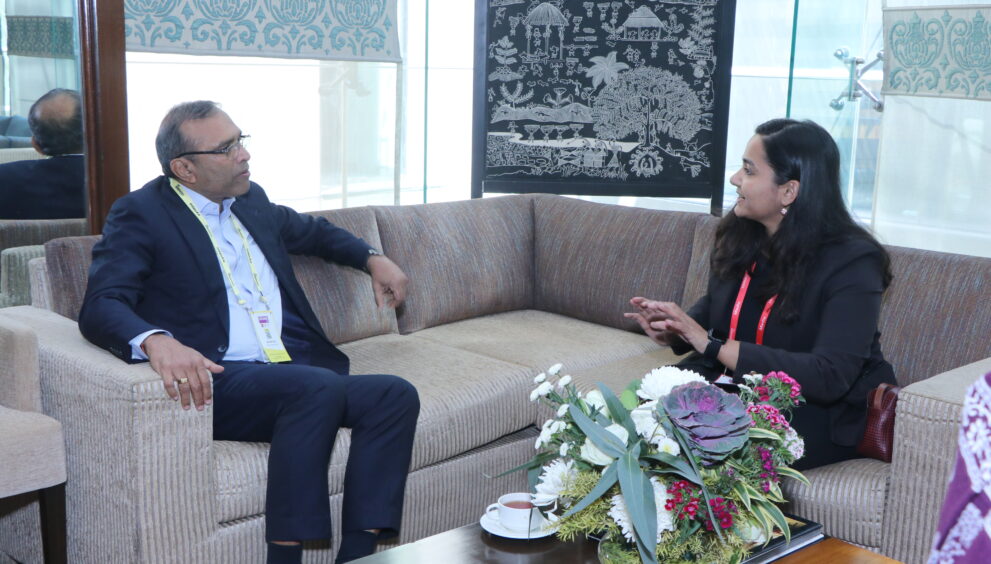“Social Has Always Been The Main Pillar At Hindalco” – Satish Pai, Managing Director, Hindalco

At The Exchange 2024, hosted by Hindalco in collaboration with Xynteo, Satish Pai, Managing Director of Hindalco shared with BW Businessworld how the company is leading the sustainability agenda with a stark focus on the S of ESG (Environment, Social, and Governance).
Question: Given that Hindalco is in the mining industry, how are you trying to green your operations? What are some of the challenges that you would like to highlight?
‘Greening our operations’ is a very broad term. Our whole approach to greening the operation involves looking at it based on a number of broad terms. The first lens through which we look at it is ‘Energy’ because aluminium is very power intensive. The second is ‘Waste’. We have taken a target of zero waste to landfill by 2040. Third is ‘Biodiversity’ as we want to ensure that there is no net loss in forest cover. Fourth is the ‘Circular Economy’. We are focusing our efforts on identifying how we can recycle and recirculate. We take sustainability across all these parameters in our plants.
We have a Sustainable Mining Charter which is our blueprint for sustainable mining. Mining has got its own unique set of challenges. On the mining side, biodiversity and livelihood are major parts. One of our major initiatives is the ‘Kosala Project’. In the area around the mines, we realised very quickly that we would not be able to employ all the people affected by mining. But there are not that many jobs in the mine itself and that has been the model so far. But if you are going to use technology and automation to make mining green, then you don’t need thousands of people with axes and carrying ore on their heads. That’s the picture that most people see. So, we started to look at how we can generate livelihood. The other aspect is that a mine has 20 to 30 years of life. The major question we were posed with, “What happens after that?” If you give people jobs in the mine, when the mine closes, they are back to poverty. We wanted to create jobs and make it sustainable so that even after the mines are gone, they will be employed. At the same time, we saw the art of kosa fading away and thought of it as an opportunity to expand.
Question: Kosala is one great initiative through which you are generating job opportunities. What are the other ways Hindalco is indulging in to generate livelihoods?
We are also looking into skilling initiatives. We built skilling institutes in Renukoot and Sambalpur. We found that India has thousands of Industrial Training Institutes (ITIs) but the people coming out of these ITIs are not employable by us because they don’t have the skillset we require. For example, they don’t know how to be a good electrician, a good welder, or a good mechanical maintenance person. To ensure the people coming out of ITIs become employable by us, we decided to make skilling centres. We are going to build three skilling centres in Orissa, Belur, and a bigger centre in Renukoot where the young people in that catchment area can come for training. Our people too can be trained there and can attain the skills that we as an industry know are required and employable.
For any discussion on the ‘Social’ pillar, there are some things that the corporates can do but there are some spaces where the society must change. There was a discussion about women in the workforce. Women are the biggest enemy of women in the workforce. The majority of the mothers and aunts push the young girls to get a degree and a job, then get married, have kids, and settle down. That’s the big push. So how do you get the women to come and work if there is constant pressure on them to settle down? This does not come from men only. It comes from the women’s side more. We have hired women. The government allows them to go on night shifts, but often parents don’t allow them.
The young generation and women will have to figure out how to break this social pressure because corporations are stepping forward in hiring women. But the problem is that the companies cannot hire women and just keep them in Bombay or Delhi and give jobs that are 9 to 5 and then have you only in functional profiles. Women are needed in the shop floors, plants, and mines. Nobody wants to do a night shift, but it must be done as part of work. It comes in rotation. It got highlighted to me because some young boys felt they were being discriminated against. They said, “You put women in the shifts, but they do only two. When you do the rotation of three, I only end up with the night shift.”
The corporates are changing, we are becoming liberal, but the people need to change their mindsets, the society needs to change as well. Now, 40 per cent of the engineers we hire at the entry level are women, I am not talking about the admin and human resource functions. These women must be working on the shop floor and night shifts.
Question: We are focusing on the social pillar of sustainability, but the growth must be profitable in the long run. What are the different ways in which you measure the rate of return on investment in sustainability?
Sustainable means that it keeps making money and it is not based on charity, otherwise it is not sustainable. We don’t measure the rate of return on sustainability. It is like saying how do you measure the return of return on safety or corporate governance. Everything cannot be boiled down to the Internal Rate of Return (IRR). The way I look at it is that if you do not operate in a sustainable way going forward, you will have no IRR because the companies will be shut down. Whatever you do needs to make economic sense going forward. If the activity being undertaken is a burden, then as soon as the results go down, the companies will stop doing it. So, for it to be sustainable, it must make economic sense. It cannot be seen as a huge extra cost that does not give any benefit.
The people working in our smelters must wear these D3 coveralls. A D3 coverall does not burn with the splash of metal. They are very expensive. So, we decided that all the people in the smelter were going to get D3 coveralls. It was a huge investment. But since that has happened, we’ve had no incidents of splashes where anyone got burnt, hurt, or died. I find that an amazing return on sustainability. It is a huge social return. People don’t feel scared to work in those places because they know they have full protection. The older people are used to doing these jobs, but the younger generation will not do this job unless you show them that you care about their safety and health and you are going to give them the right protective equipment.
Question: What are the key governance metrics that you think are required in the current times and how do you think companies can make the most out of it?
Governance has become an exercise of compliance with regulations. Companies must comply with regulations, but if you don’t look at what are you trying to achieve with governance, there is a danger that you will comply, but not go for ‘Good Governance’. That was the first thing I realised because it was the same with safety and sustainability.
My issue with governance is that a lot of corporate India is in that compliance-driven regulation. The key points we have to solve in governance are that first, there has to be transparency in the data. It must be audited by third-party reliable people so that as an employee, an investor, and a stakeholder, people get to know what exactly the company is doing and what it stands for. That is one basic line in governance. Secondly, management performance, management pay, and management evaluation must be transparent, which is not today. The stakeholders of the companies should know exactly how the Chief Executive Officer (CEO) is compensated, what the CEO’s objectives are, and how is the CEO evaluated – that is an important part. Thirdly, the boards in India need to be more proactive. There should be a focus on the composition of boards today, the independence, and the diversity of boards. People feel it is honourless to be on board of a company. A lot of people are on multiple boards.
I am on Hindalco’s board and one other. I find it amazingly time-consuming. People should give quality time when they are on board. To summarise, we need to shift from complying with regulations and opting for good governance.





























































































































































































































































































































































































































































































































































































































































































































































































































































































































































































































































































































































